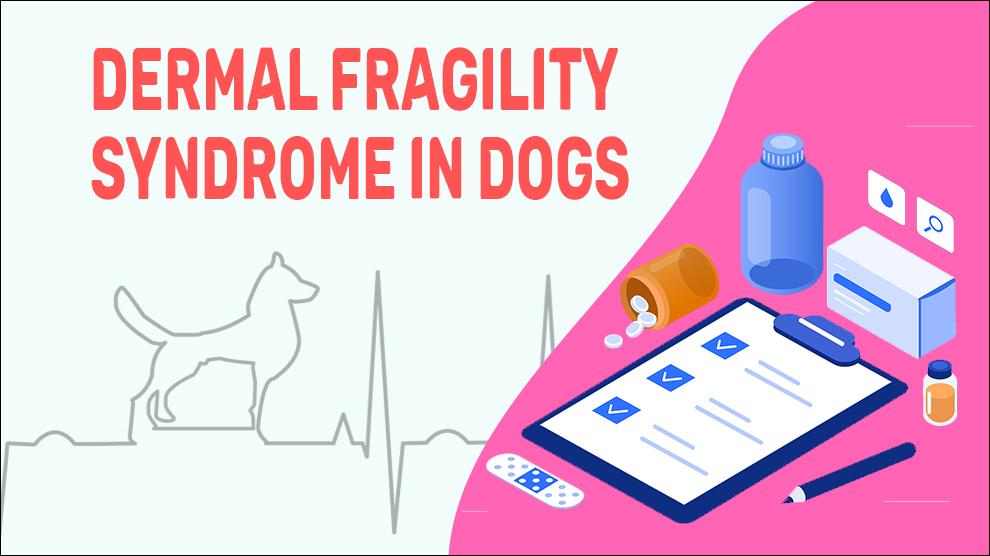Dermal fragility syndrome is an inherited, autosomal recessive, heterogeneous group of inherited connective tissue disorders that results in defective collagen synthesis and structure.
In 1901, French physician Henri Danlos from France and Danish dermatologist Edvard Ehlers initially described this syndrome in humans.
Also called Ehlers-Danlos syndrome, dermatosparaxis, or cutaneous asthenia, this is generally described as the defects in structural elements responsible for the integrity of the epidermis and dermal-epidermal junction. The affected dog has thin, fragile, and stretchy skin that is abnormally droopy and saggy.
With very little trauma, the stretchy skin will be prone to tears and can cause gaping “fish mouth” type wounds with minimal hemorrhage. These skin tears can result in painful blisters and erosions and may get infected, leading to hematomas and scarring.
Disorders in the skin fragility syndrome or Ehlers Danlos group are really rare in dogs. The skin may tear even with normal grooming, gentle handling, or restraint.
Symptoms Of Dermal Fragility Syndrome
- Fragile, thin, or delicate skin with little elasticity
- Stretchy or loose with redundant folds of skin
- Hyperextensible skin
- Skin bruising/Painful skin tears
- Hard blood masses under the skin or Subcutaneous hematoma
- Soft, fluid-filled sacs that form over a bony prominence (Hygroma formations)
- Extensive scarring/ Delayed wound healing
- Dysfunction of connective tissues
- Weakened blood vessels
- Increased infections
- Laxity in joints
- Lameness
- Eye abnormalities (lens luxation, cataracts)
- Females dogs: uterine rupture or prolapsed, pregnancy complications
Treatment Options For Dermal Fragility Syndrome
- NSAIDs like
- Metacam (meloxicam)
- Deramaxx (deracoxib)
- Rimadyl (carprofen)
- Previcox (firocoxib)
- EtoGesic (etodolac)
- Corticosteroids like oral prednisone or methylprednisolone.
- Alternative steroids for prednisone- and methylprednisolone-refractory cases include dexamethasone and triamcinolone.
- Immunosuppressive drugs, such as cyclosporine, azathioprine, or chlorambucil.
- Nonsteroidal immunosuppressive drugs include tetracycline/niacinamide and gold salts.
- For reduction of swelling and inflammation in joints, Prednisone, dexamethasone, and other corticosteroids will be prescribed for a short duration.
- Chronic hygromas: these are drained using a drain tube, needle aspirations, or flushing.
Home Remedies For Dermal Fragility Syndrome
- Medicated baths: Medicated baths (weekly or every other week) with medicated shampoos and antimicrobial and antifungal agents relieves injured skin and remove allergens that cause skin allergy flare-ups. Afterward, apply a rinse to prevent drying out of the skin and hair coat.
- Dogs with skin folds can be cleaned daily with a clean, damp cloth, shampoo, wipes, ointment, lotion, spray, skin cleanser, etc.
- Regularly brush the dog to reduce shedding. Consistent grooming spreads the skin’s natural protective oils across the surface.
Prevention Of Dermal Fragility Syndrome
Dermal fragility etiology is poorly understood. Specific causes are not yet known. However, Hereditary is, perhaps a factor in many breeds and it is better to evaluate the affected dogs before breeding or at least before getting a dog from a susceptible lineage.
Don’t skip visits to the vet including yearly once the comprehensive examination. Ask Your Veterinarian about skin Supplements and maintain your dog's optimal weight.
Affected Breeds Of Dermal Fragility Syndrome
English Springer Spaniel, Daschund, Beagle, Saint Bernard, Boxer, English Setter, Greyhound, German Shepherd, Keeshond, Irish Setter, Poodle, Manchester Terrier
Additional Facts For Dermal Fragility Syndrome
1. Causes:
The genetic abnormality causes an aberration in collagen structure and production, which then causes the skin fragility and flexibility. This is an autosomal recessive inheritance, which means to for the condition to occur only in the puppies, only one copy has to be transmitted. When the carrier dog is bred with a healthy one, the offsprings have a 50% chance of inheriting this syndrome.
2. Mortality:
Mortality due to skin fragility is rare. While skin fragility disease is not life-threatening, it is certainly life-changing. The restricted mobility and the pain in a dog’s daily life are something to be endured.
3. Diagnosis:
- History and physical examination
- Skin extensibility index
- Skin biopsy
4. Prognosis:
Veterinarians usually give suggestions for control or management of the problem since there is no proper cure.
Skin fragility has a guarded prognosis.
Dogs that receive early diagnosis and appropriate treatment have a better prognosis than dogs with chronic conditions.
When To See A Vet
Contact your vet right away, if you notice any of the following:
- Unwillingness to walk, reluctant to climb stairs, play or jump
- Lameness/ abnormal gait
Food Suggestions For Dermal Fragility Syndrome
Whole Foods
- Vitamin-rich veggies: Cauliflower, zucchini, Broccoli
- Antioxidant-packed fruits: Cantaloupe, Blueberries, cherries, peeled apple
- Leafy greens: Kale, Spinach, collards
- Fiber-filled veggies: Pumpkin, Sweet potato, acorn squash
- Lean protein: Chicken, turkey
- Fish: Salmon, sardines, mackerel, tuna
Oils
- Omega-3 oils: green-lipped mussel oil, Fish oil
- Flaxseed oil (sprinkle over dog’s food)
- Coconut oil (use to sauté dog’s veggies or mix in with dog’s food)
Conclusion
In general, Most dogs with skin fragility syndrome can be satisfactorily treated. Only in genetically predisposed dogs, it is usually a lifelong condition requiring continuous management.
After immunosuppressive therapy is tapered and discontinued, some dogs may remain in remission and they require lifelong therapy to control remission. With proper care, animals that are affected can live their normal life span; however, repeated trauma episodes may necessitate a request for euthanasia.

















